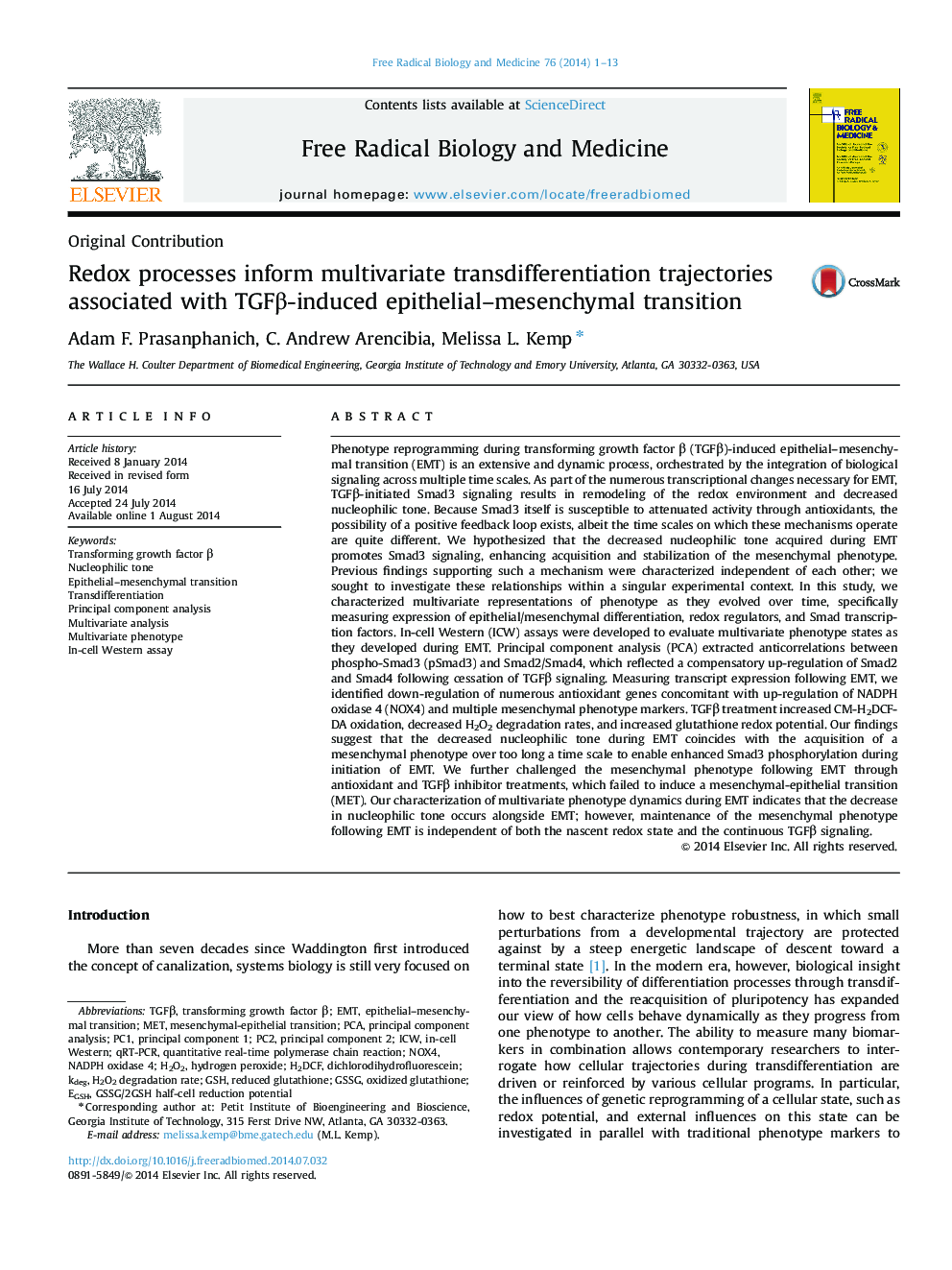| کد مقاله | کد نشریه | سال انتشار | مقاله انگلیسی | نسخه تمام متن |
|---|---|---|---|---|
| 8269772 | 1534966 | 2014 | 13 صفحه PDF | دانلود رایگان |
عنوان انگلیسی مقاله ISI
Redox processes inform multivariate transdifferentiation trajectories associated with TGFβ-induced epithelial-mesenchymal transition
دانلود مقاله + سفارش ترجمه
دانلود مقاله ISI انگلیسی
رایگان برای ایرانیان
کلمات کلیدی
kdegICWPC1H2DCFPC2GSHTGFβNOX4qRT-PCRGSSGdichlorodihydrofluoresceinNADPH oxidase 4 - NADPH اکسیداز 4PCA - PCAHydrogen peroxide - آب اکسیژنهmesenchymal-epithelial transition - انتقال مزانشیمال-اپیتلیالTransforming growth factor β - تبدیل فاکتور رشد βPrincipal component analysis - تحلیل مولفههای اصلی یا PCAMultivariate analysis - تحلیل چندمتغیرهTransdifferentiation - تمایز متقابلEMT - تکنسین فوریتهای پزشکیprincipal component 1 - جزء اصلی 1principal component 2 - جزء اصلی 2MET - ملاقات کردH2O2 - هیدروژن پراکسیدquantitative real-time polymerase chain reaction - واکنش زنجیره ای پلیمراز کمی زمان واقعی استreduced glutathione - کاهش گلوتاتیونEpithelial–mesenchymal transition - گذار اپیتلیال-مزانشیمیoxidized glutathione - گلوتاتیون اکسید شده
موضوعات مرتبط
علوم زیستی و بیوفناوری
بیوشیمی، ژنتیک و زیست شناسی مولکولی
سالمندی
پیش نمایش صفحه اول مقاله

چکیده انگلیسی
Phenotype reprogramming during transforming growth factor β (TGFβ)-induced epithelial-mesenchymal transition (EMT) is an extensive and dynamic process, orchestrated by the integration of biological signaling across multiple time scales. As part of the numerous transcriptional changes necessary for EMT, TGFβ-initiated Smad3 signaling results in remodeling of the redox environment and decreased nucleophilic tone. Because Smad3 itself is susceptible to attenuated activity through antioxidants, the possibility of a positive feedback loop exists, albeit the time scales on which these mechanisms operate are quite different. We hypothesized that the decreased nucleophilic tone acquired during EMT promotes Smad3 signaling, enhancing acquisition and stabilization of the mesenchymal phenotype. Previous findings supporting such a mechanism were characterized independent of each other; we sought to investigate these relationships within a singular experimental context. In this study, we characterized multivariate representations of phenotype as they evolved over time, specifically measuring expression of epithelial/mesenchymal differentiation, redox regulators, and Smad transcription factors. In-cell Western (ICW) assays were developed to evaluate multivariate phenotype states as they developed during EMT. Principal component analysis (PCA) extracted anticorrelations between phospho-Smad3 (pSmad3) and Smad2/Smad4, which reflected a compensatory up-regulation of Smad2 and Smad4 following cessation of TGFβ signaling. Measuring transcript expression following EMT, we identified down-regulation of numerous antioxidant genes concomitant with up-regulation of NADPH oxidase 4 (NOX4) and multiple mesenchymal phenotype markers. TGFβ treatment increased CM-H2DCF-DA oxidation, decreased H2O2 degradation rates, and increased glutathione redox potential. Our findings suggest that the decreased nucleophilic tone during EMT coincides with the acquisition of a mesenchymal phenotype over too long a time scale to enable enhanced Smad3 phosphorylation during initiation of EMT. We further challenged the mesenchymal phenotype following EMT through antioxidant and TGFβ inhibitor treatments, which failed to induce a mesenchymal-epithelial transition (MET). Our characterization of multivariate phenotype dynamics during EMT indicates that the decrease in nucleophilic tone occurs alongside EMT; however, maintenance of the mesenchymal phenotype following EMT is independent of both the nascent redox state and the continuous TGFβ signaling.
ناشر
Database: Elsevier - ScienceDirect (ساینس دایرکت)
Journal: Free Radical Biology and Medicine - Volume 76, November 2014, Pages 1-13
Journal: Free Radical Biology and Medicine - Volume 76, November 2014, Pages 1-13
نویسندگان
Adam F. Prasanphanich, C. Andrew Arencibia, Melissa L. Kemp,